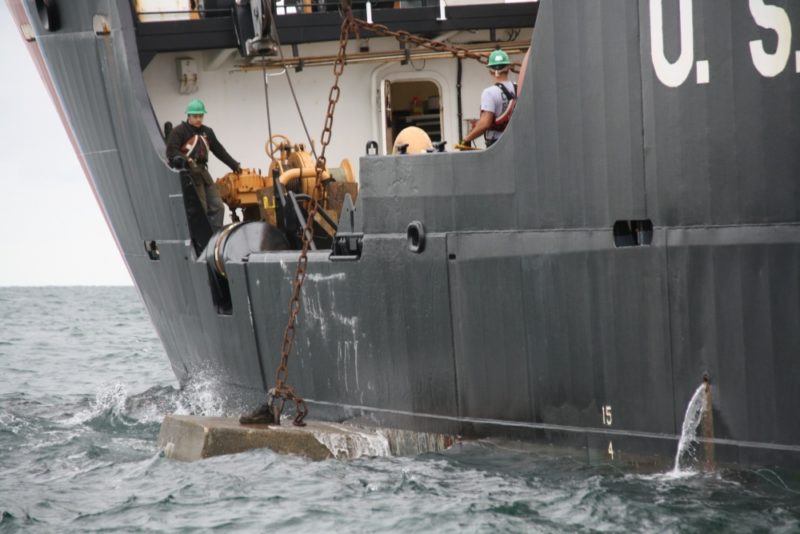The U.S. Coast Guard has recycled more than 140,000 lbs. of concrete buoy sinkers on an artificial reef near Yarmouth, Mass.
U.S. Coast Guard Cutter Oak (WLB-211) and Aids to Navigation Team (ANT) Woods Hole, Mass., used the discontinued concrete sinkers to support the Massachusetts Division of Marine Fisheries’ artificial reef program. Used to anchor buoys in place, concrete sinkers come in a variety of sizes and weights, from 100 lbs. to 20,000 lbs.
Lt. Dan Miller, the executive officer of the Newport, R.I.-based Oak, said the artificial reef operation gave crewmembers the chance to complete training and annual weight testing of the buoy handling gear.
Coast Guardsmen recycled the concrete sinkers across a one-acre area of the artificial reef. The program is a valuable resource for commercial and recreational fishermen to cultivate sustainable fisheries, said Miller.
According to the Massachusetts Division of Marine Fisheries, the artificial reef “provides desirable habitat for finfish and lobsters in an otherwise featureless area.”
“Artificial reefs enhance habitat by providing structures in structure-limited areas,” said Mark Rousseau from the Massachusetts Division of Marine Fisheries. “We expect to see reef associated fish occupying the area around the deployed material by next year.”
“Artificial reefs are an important fisheries management tool used in Massachusetts to provide additional access for recreational anglers to valuable marine species,” said Rousseau.
Commercial and recreational fisheries support more than 97,000 jobs in Massachusetts, according to a National Oceanic and Atmospheric Administration (NOAA) report on Fisheries Economics in the U.S.
“The 128-acre artificial reef, developed in 1978, is challenged by the lack of available rubble material necessary to attract and sustain a variety of fish species,” said Miller.
“These sinkers were left in our storage area over the past decade,” said Miller, a Littlestown, Pa., native who has served in the Coast Guard for eight years. “In the past year, it cost the First District approximately $10,000 to remove 200 tons of concrete sinkers from the pier.”
“We were able to remove 60 tons while (simultaneously) completing training to the benefit of the district, our unit and state partners and improving the local fishing industry,” said Miller.
Senior Chief Petty Officer Manuel Gonzales, the officer-in-charge of Aids to Navigation Team (ANT) Woods Hole, Mass.,, said his team jumped at the opportunity to participate in the operation.
“At the ANT, we use 1,000 to 4,000 pound sinkers,” said Gonzales. “When they start to show extreme signs of wear in the concrete or on the bails that attach the chain, they are replaced.”
“It is difficult to dispose of concrete sinkers,” said Gonzalez, an 18-year U.S. Coast Guard veteran from Whittier, California. “It was great to find out we can help the marine ecosystem while minimizing the buildup of used sinkers in our storage areas.”
From the U.S.-Canadian border to Buzzards Bay and Nantucket, Mass., the Oak maintains 144 Aids to Navigation (ATON) and supports a wide variety of other missions. The seagoing buoy tender services buoys and beacons that guide ships into Boston; Portsmouth, New Hampshire; and Portland, Maine.
ANT Woods Hole services more than 232 buoys, 72 beacons and approximately 1,100 Private ATON from the Cape Cod Bay to Nantucket and Martha's Vineyard.
The U.S. Coast Guard maintains more than 48,000 ATON across more than 25,000 miles of navigable American waterways that facilitate the safe movement of millions of mariners and trillions of dollars of trade every year.
In 2018, U.S. waterways generated $5.4 trillion in economic activity. The U.S. Coast Guard charted the way ahead for its waterways missions in its first ever Maritime Commerce Strategic Outlook.
Rousseau from the Division of Marine Fisheries said the buoy sinker operation was the first of what he hoped would be many collaborative efforts with the Coast Guard to support artificial reefs. “This project is a prime example of state and Federal government working together to reduce costs through repurposing and recycling materials while providing added environmental benefits,” said Rousseau.





